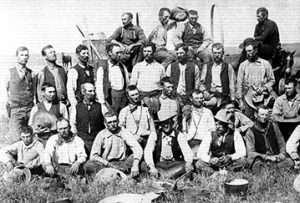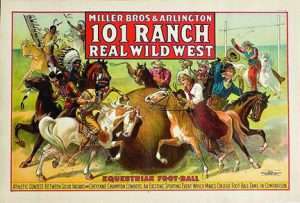When George W. Miller left his home state of Kentucky in 1869, he likely never dreamed of one day overseeing a huge Oklahoma Ranching empire, or that his sons would place the family name on a pioneering Wild West Show, but as it turned out, the visionary and ambitious Miller and his sons did just that.
George Washington Miller was born into a prosperous farming family on February 22, 1841, near the town of Crab Orchard, an early pioneer station on the Wilderness Road in the rolling hills of central Kentucky. Even though Kentucky was a so-called neutral state, Miller considered himself a true southerner and backed the Confederacy. Throughout his life he referred to the War Between the States as “The War of Northern Aggression.”
In 1866, twenty-five-year-old George married nineteen-year-old Mary Ann “Molly” Carson, his second cousin and stepsister. They tried to make a go of the plantation he had purchased from his grandfather, but Post-Civil War Reconstruction made for difficult times in loyalty-divided Kentucky, especially for men like Miller. The loss of slaves, among other things, gave rise to the decision to leave his home state for California and a new life as a rancher and farmer, and in 1869, Miller, his wife, their daughter and infant son, Joseph Carson Miller, departed Kentucky for the far West.
A winter stop-over in the southwest Missouri town of Newtonia introduced Miller to the cattle industry. He was fascinated, and instead of going on to California, he spent the next thirty years trail driving and raising cattle in Kansas, Indian Territory and Oklahoma.
Miller began his ranching career near Baxter Springs, Kansas, in 1871 as the partner of Texas cattleman Lee Kokernut. By then Baxter Springs had become the first Kansas Cowtown with a railroad line direct to the main shipping point at Kansas City, Missouri. Miller and Kokernut used the “Reverse LK” cattle brand and held pasture in southeastern Kansas and northeastern Indian Territory. By the mid-1870s young Joe Carson Miller, the oldest son, was starting to “cowboy” with his dad, and in 1878 a second son, Zachery Taylor, was born. The following year Miller moved his family from Newtonia to a ranch at Baxter Springs, and soon started leasing sixty thousand acres of range in the pasture-rich Cherokee Outlet of Indian Territory, dividing his holdings into two ranches. The Outlet’s northern most pasture was called “Deer Creek,” located along a creek so named and near where the town of Deer Creek was later established. The southern pasture, known as “Salt Fork,” was south of the Salt Fork River near present-day Lamont, Oklahoma.
By 1880 George Miller bought out Lee Kokernut, and moved all ranching operations into the Outlet. In the years that followed, he drove most of his cattle from Texas up the Chisholm Trail, then northeast along the “Arkansas City Freight Road” to where the “Hunnewell Trail” branched north near present-day Lamont. The “Hunnewell Trail” ran almost directly between Miller’s two pastures and on to Hunnewell, Kansas, just across the Indian Territory border.
When Hunnewell was first platted in 1880, Miller bought ninety-four acres of land west of town where he built loading pens, shelters and other facilities making Hunnewell his principal trail driving destination and railroad shipping point. To conduct his cattle business, Miller required a large heard of horses and kept a full-time crew year-round in Hunnewell to care for the stock coming in off the trail. Between drives, the crew busied themselves with breaking and caring for new horses that were shipped in to replenish his herd.
In those early days, the 101 Ranch bought most of its supplies in Hunnewell which had one of the biggest outfitting stores in southern Kansas. The structure was built with heavy plank floors so that a cowboy could ride his horse right into the building, buy his goods and leave by another door. The sturdy structure, now long-gone, was located across the street south of the three-story Hunnewell House Hotel.
It was during this period of Miller’s ranching in the Cherokee Outlet that he first employed the “101” brand. Years later, the family recalled that John Hiatt, a range-hand and nephew to George Miller, “built the brand fire that burned the first ‘101’ on a cow.” Miller made up several irons, some for branding the cow’s horn, others for conventional branding on the hide.
According to John Hiatt’s memoirs, the “101” brand had nothing to do with the amount of land the Miller’s eventually owned, a misconception that came about in later years. Rather, the brand dates to a much earlier time and was derived from George Miller’s unique way of punishing his wild, drinking-prone cowhands. Hiatt said the “101” mark was first used on a cattle drive north from San Antonio. He explained that “when the boys arrived in town, they were in the habit of getting falling down drunk, usually at their favorite San Antonio saloon named the ‘101.’’’ Rounding up his bunch to work the next day after their first hell-raising night in town was difficult and time-consuming for Miller, and it usually involved the local police, court fines and several trips back and forth to town gathering his men before they could begin their drive back north. Miller came up with a plan for payback and told the boys, “When I’m through you’ll wish you’d never seen the ‘101’ because I’m gonna’ make you put it on every cow I own!” That was the beginning of the “101” brand, not only on livestock but just about everything else that belonged to the Millers.
On September 9, 1881, a third son, George Lee Kokernut Miller, was born to George W. and “Molly” Miller at the family home in Baxter Springs. Later that year, Miller decided to move closer to his ranch holdings in the Cherokee Outlet and bought a home in Winfield, Cowley County, Kansas. Although the Millers appreciated the cultural and social activities in Winfield, they kept their children out of public schools, tutoring their three boys and sister Alma, at home, but Joe and Zack spent most of their time working cattle their father.
The elder Miller, then in his early forties, personally watched over his cattle holdings and often lived with his crew in their first ranch headquarters along the Salt Fork River. About 1880 they built a combination cabin and dugout that consisted of three rooms, and with it a branding pen, storage for feed corn, and a crude horse barn. Miller’s day-to-day work on the cattle range was illustrated by a Winfield Courier newspaper article dated November, 1883. It reported a “cattle thief was caught by George W. Miller about twelve miles west of Wichita.” Miller trailed the man from the Outlet and “followed him around the country until he finally caught up with him.” Miller “pulled his Winchester,” said the newspaper, and took him to jail. It concluded that, “George is a good thief catcher.”
In 1893, shortly before the Cherokee Outlet opened to settlement on September 16, Miller began leasing thousands of acres of additional pasture along the Salt Fork River on the Ponca Indian Reservation. The lease price was only a penny per acre; a superb deal made possible because the Miller family had been friendly to the Ponca Tribe for years. They had helped feed the Poncas when the tribe was first forced into Eastern Indian Territory a few years before, and, ultimately helped them negotiate with the government for more suitable reservation land in the Cherokee Outlet. Thus, leasing reservation land to the Millers was an easy choice for Ponca leader White Eagle, and by 1902, Miller had 50,000 acres in pasture and under cultivation. A year later, the federal government began allowing the Poncas to sell land to the Millers. That, along with other negotiated purchases from the Otoe, Pawnee and Osage tribes, eventually allowed the 101 Ranch to extend into parts of four Oklahoma counties, establishing what we know today as the sprawling 101 Ranch on land then actually owned by the Miller family.
As it happened, George Miller never saw his ultimate vision for the ranch, including the landmark home that came to be called the “White House.” On April 25, 1903, he died of pneumonia in a crude dugout the Millers then used as their new ranch headquarters. His wife had the ranch turned into a trust with Joe as chairman and Zack and George as the only other members. The sons divided responsibilities with Joe running the overall operations and farming, Zack controlling the livestock, and George handling the finances.
With their father gone, the sons continued his vision, ultimately building the 101 Ranch into a highly diversified farm and stock raising complex that was supported by its own on-site electric plant, a cannery, a dairy, a tannery, a store, and several different mills. In 1905, the forward-thinking brothers ventured into show business by staging a Wild West exhibition and rodeo at the 101 Ranch. The Miller “Midas Touch” had struck again, and the exhibition evolved into the World famous 101 Wild West show.
The vision of George W. Miller and his sons will be celebrated Friday and Saturday March 24 & 25, 2023, in Blackwell, Oklahoma during the annual 101 Ranch Western Memorabilia Show. The event at the Kay County Fairgrounds Livestock Center features 101 Ranch and Wild West Show artifacts as well as other Western memorabilia for viewing or sale including original cowboy gear, firearms, assorted antiques, rare photos and ephemera.
The show, presented by the 101 Ranch Collectors’ Association, is open to the public Friday 1 pm to 6 pm and Saturday 9am to 4pm.





